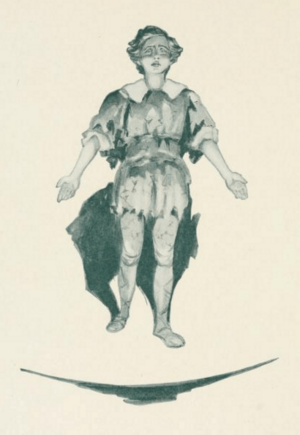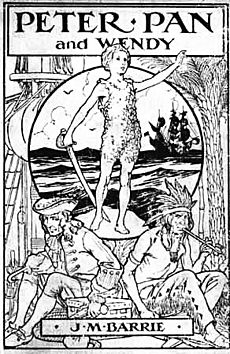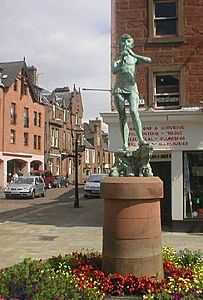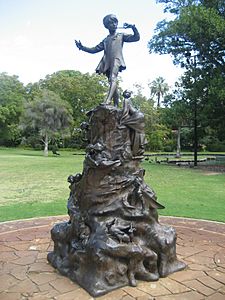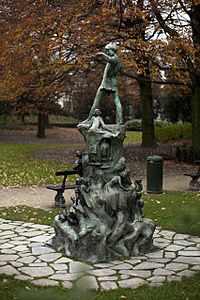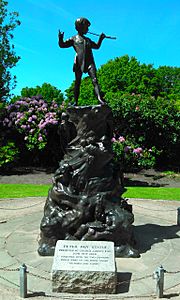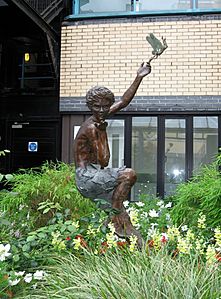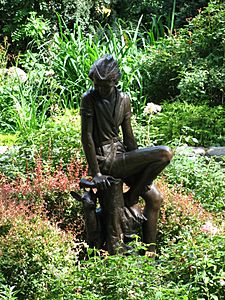Peter Pan facts for kids
Quick facts for kids Peter Pan |
|
|---|---|
| Peter Pan character | |

Illustration of Peter Pan playing the pipes, by F. D. Bedford from Peter and Wendy (1911)
|
|
| First appearance | The Little White Bird (1902) |
| Created by | J. M. Barrie |
| Portrayed by | Nina Boucicault (1904 play) Maude Adams (1905 play) Betty Bronson (1924 film) Mary Martin (1954 musical) Robin Williams (Hook) Jeremy Sumpter (2003 film) Robbie Kay (Once Upon a Time) Levi Miller (2015 film) |
| Voiced by | Bobby Driscoll (1953 film) |
| Information | |
| Aliases | The Boy Who Wouldn't Grow Up |
| Species | Human |
| Gender | Male |
| Nationality | English |
Peter Pan is a famous fictional character created by Scottish writer J. M. Barrie (1860–1937). He is a special boy who can fly and never grows up. Peter Pan spends his endless childhood on the magical island of Neverland. He leads a group of boys called the Lost Boys. Peter is always with his fairy friend, Tinker Bell.
Contents
How Peter Pan Started
J. M. Barrie first wrote about Peter Pan in his 1902 novel, The Little White Bird. In this book, Peter is a seven-day-old baby. Later, in 1906, parts of this book were published as Peter Pan in Kensington Gardens. This version included new pictures by Arthur Rackham.
Peter Pan then became the main character in a stage play called Peter Pan, or The Boy Who Wouldn't Grow Up. It first opened in London on December 27, 1904. Barrie later turned this play into a novel in 1911, which was called Peter and Wendy.
What Peter Pan Looks Like
Barrie never gave a lot of details about Peter's looks. This allowed readers and artists to imagine him in their own ways. In the play, Peter wears clothes made from autumn leaves and cobwebs. His name and his love for playing the pipes remind people of the Greek god Pan. In the book Peter and Wendy, Barrie says Peter still has all his "first teeth." He describes Peter as a handsome boy with a lovely smile.
For a long time, Peter Pan was played on stage by a small adult woman. In early UK shows, Peter wore a reddish tunic and dark green tights. This is what Nina Boucicault wore in 1904. A similar costume is shown at the Museum of London. Over time, a green costume became more common, especially after Disney's animated movie.
In the Disney films, Peter wears a short-sleeved green tunic and tights. He also has a cap with a red feather. He has pointed elf-like ears, brown eyes, and red hair. In the movie Hook (1991), an adult Peter is played by Robin Williams. He has blue eyes and dark brown hair. His ears are pointed only when he is Peter Pan. In the 2003 Peter Pan film, Jeremy Sumpter plays Peter. He has blond hair and blue-green eyes. His outfit is made of leaves and vines.
Peter Pan's Age
J.M. Barrie based Peter Pan on his older brother, David. David died in an ice-skating accident just before his 14th birthday. His family always remembered him as a young boy. Peter Pan, "the boy who wouldn't grow up," is shown at different ages.
- In The Little White Bird (1902) and Peter Pan in Kensington Gardens (1906), he is only seven days old.
- In Barrie's play (1904) and novel (1911), his exact age isn't given. However, the book says he still has all his baby teeth. But in other ways, he seems older, around 12–13 years old.
Peter Pan's Personality
Peter is a very boastful and carefree boy. He often brags about himself, even when it's not really true. For example, he congratulates himself when Wendy helps him re-attach his shadow. In the play and book, Peter shows the selfish side of childhood. He is often forgetful and thinks mostly about himself.
Peter has a very relaxed and daring attitude. He is fearless when he faces danger. Barrie wrote that when Peter thought he might die, he felt scared for only a moment. With his brave attitude, he says, "To die will be an awfully big adventure."
Peter Pan's Special Abilities
Peter's most famous quality is that he stays young forever. In Peter and Wendy, it's explained that Peter has to forget his adventures and what he learns. This helps him stay like a child.
Peter's ability to fly is explained in different ways. In The Little White Bird, he can fly because he is partly a bird, like all babies. In the play and novel, he teaches the Darling children to fly. He tells them to think "lovely wonderful thoughts" and then uses fairy dust. Barrie added the idea of fairy dust for flying because some children tried to fly from their beds after seeing the play and got hurt!
Peter also has a special effect on Neverland. The island "wakes up" when he returns from London. In the book Peter and Wendy, Barrie writes that Peter can do almost anything. He is a very skilled swordsman, even better than Captain Hook. He cut off Hook's hand in a fight. Peter has amazing eyesight and hearing. He is also good at copying voices, like Hook's voice or the crocodile's ticking sound.
Peter can imagine things into existence. He can also sense danger when it is near.
Cultural Meaning
Peter Pan's name comes from two places. One is Peter Llewelyn Davies, one of the boys who inspired the story. The other is Pan, a Greek god who plays pipes for nymphs. This god is part human and part goat. In Barrie's stories, Peter Pan plays pipes for fairies and rides a goat. The god Pan represents nature and freedom. Peter Pan is also a free spirit. He is too young to be held back by rules or to fully understand right and wrong.
Relationships

Peter Pan's Family
Peter Pan ran away from his parents when he was a baby. This is told in Peter Pan in Kensington Gardens and Peter and Wendy. When he came back later, he saw his window was closed and there was a new baby in the house. He thought his parents didn't want him anymore, so he never returned.
Peter Pan's Friends
Maimie Mannering
In Kensington Gardens, Peter meets a lost girl named Maimie Mannering. They quickly become friends. Peter even asks Maimie to marry him. Maimie wants to stay with Peter, but she realizes her mother is worried. So, she goes back home. Maimie always remembers Peter, sending him gifts and letters. Peter remembers Maimie by riding an imaginary goat she created for him. Maimie is seen as an early version of Wendy Darling.
The Darling Family
Wendy Darling
Wendy seems to have romantic feelings for Peter. But they can't be together because Peter can't truly love back. In the 2003 film Peter Pan, Peter also has feelings for Wendy. Captain Hook can only stop Peter from flying by making him think Wendy will leave him, grow up, and find a husband. Wendy saves Peter by giving him her hidden kiss. This gives him the will to live. In the movie Hook, an older Wendy hints that she used to have feelings for Peter. She was surprised he didn't stop her wedding day. In the sequel to the 1953 Disney film, Return to Never Land, Peter and a grown-up Wendy meet again happily. They still show feelings for each other.
In the original book, Peter later becomes friends with Wendy's daughter Jane. He also befriends Jane's daughter Margaret. It seems this pattern will continue forever. Peter sometimes visits the real world and makes friends with children. Wendy Darling, whom he asks to be his "mother," is the most important of these friends. He also brings her brothers John and Michael to Neverland. Wendy was the only girl who truly caught his attention.
John Darling and Michael Darling
John is the older brother of the Darling children. He is very mature for his age. He loves pirates and pretends to be Captain Hook when playing with his siblings. John is smart and brave. Peter often asks John to lead the Lost Boys when Peter is not there. Michael is the youngest Darling child. He believes Peter Pan is real after hearing Wendy's exciting stories. When they play, Michael always pretends to be Peter Pan, whom he looks up to.
Mary and George Darling
These are Wendy, John, and Michael's parents. Mr. Darling works in the City. He is named after George Llewelyn Davies. Mrs. Darling is named after Mary Ansell, Barrie's wife.
Neverland Friends
Tiger Lily
Tiger Lily is the daughter of Great Big Little Panther. He is the chief of the Piccaninny Native American tribe in Neverland. Barrie calls her "a princess." Pirates kidnap her and leave her to die, but Peter rescues her. It is suggested she might like Peter, but he doesn't notice her feelings. In the Disney film, Tiger Lily thanks Peter with a dance and a kiss. The kiss makes Peter blush, and Wendy gets jealous.
Tinker Bell
Tinker Bell is a common fairy. She is Peter Pan's best friend and often gets jealous and protective of him. She helps him in his adventures. Tink's mean actions usually come from her jealousy. This leads the Lost Boys to shoot arrows at Wendy. She even tells Captain Hook where Peter's hideout is, thinking only Wendy will be caught. When Tink realizes her big mistake, she risks her life. She drinks poison Hook left for Peter (or pushes away Hook's bomb in Disney's movie). Her loyalty to Peter is very strong.
The Lost Boys
Peter is the leader of the Lost Boys. This group includes Tootles, Nibs, Slightly, Curly, and The Twins. The Lost Boys are boys who got lost by their parents. They "fall out of their perambulators" (baby carriages) and come to live in Neverland. In Barrie's novel Peter and Wendy, it says Peter "thins them out" when they start to grow up. This is not fully explained, but it suggests he either kills them or sends them away.
In the song "I Won't Grow Up" from the 1954 musical, the boys sing "I will stay a boy forever." Peter replies, "and be banished if I don't." In Peter Pan in Scarlet (2006), the official sequel to Barrie's book, it is shown what happens. When Slightly starts to grow older, Peter banishes him to Nowhereland. This means Peter and his friends ignore the banished person's existence. Nowhereland is where all the Long Lost Boys Peter has banished live.
The Crocodile
The crocodile (named Tick-Tock in the Disney film) is Captain Hook's enemy. Peter Pan cut off Captain Hook's hand in a fight and threw it into the sea. The crocodile swallowed it and liked the taste of Hook. It also swallowed a ticking clock. This clock warns Hook when the crocodile is near.
Peter Pan's Enemies
Captain Hook
Captain Hook is Peter Pan's main enemy. Peter cut off Hook's right hand in a duel. Hook's crew, like Smee and Starkey, also see Peter as an enemy. Captain Hook is most afraid of seeing his own blood and of the crocodile. His name comes from the iron hook that replaced his hand. The crocodile ate his hand and still chases Hook.
In the 1953 animated film, Hook wants revenge on Peter Pan for feeding his hand to the crocodile. He refuses to leave Neverland until he gets it. Mr. Smee helps Hook. Hook promises Tinker Bell not to "lay a finger (or a hook) on Peter Pan." But then he puts a bomb in Peter's hideout. At the end of the film, the crocodile chases Hook away. Walt Disney wanted Hook to stay alive. He said, "The audience will get to liking Hook, and they don't want to see him killed." In the sequel Return to Never Land, Hook mistakes Wendy's daughter Jane for Wendy. He uses her to try and lure Peter Pan to his death.
Mr. Smee
Mr. Smee is Captain Hook's boatswain (bo'sun) and his main helper. He appears in J. M. Barrie's play Peter Pan and the novel Peter and Wendy. Mr. Smee is Captain Hook’s closest friend. Unlike the other pirates, Smee is often clumsy. He is not good at catching the Lost Boys. Instead of helping with Hook’s evil plans, Smee enjoys collecting loot and treasures.
Peter Pan Statues Around the World
Barrie asked sculptor George Frampton to create a statue of Peter Pan. It was put up overnight in Kensington Gardens on April 30, 1912. It was a May Day surprise for the children of London. Seven statues have been made from the original mold. The other six are in:
- Egmont Park, Brussels, Belgium, 1924
- Bowring Park, St. John's, Newfoundland, Canada, 1925
- Johnson Park, Camden, New Jersey, United States, 1926
- Queens Gardens, Perth, Western Australia, 1927
- Sefton Park, Liverpool, England, 1928
- Glenn Gould Park, Toronto, Ontario, Canada, 1929
Other statues include:
- The city of Melbourne, Australia, ordered a Peter Pan statue in 1926. It is now at the Melbourne Zoo.
- A bronze statue by Charles Andrew Hafner was made in 1928 for a fountain in New York. It is now in Carl Schurz Park, New York.
- A statue of Pan by Alex Proudfoot RSA was put up at Mearnskirk Hospital for children in Glasgow in 1949. It was a gift in memory of Dr John A Wilson, who was a friend of J.M. Barrie.
- A statue by Ivan Mitford-Barberton was given to the Red Cross War Memorial Children’s Hospital in South Africa in 1959.
- Two statues by Cecil Thomas are in Dunedin Botanic Gardens in Dunedin, New Zealand, since the 1960s. One shows Peter Pan and Tinker Bell, the other Wendy and the Darling children.
- Two bronze statues by Alistair Smart are in Kirriemuir, Scotland, since 1972. One is in the town square, and the other is in the Peter Pan Garden by Barrie's Birthplace.
- A bronze statue by Ronald Thomason was made in 1976. It is in front of the Weatherford, Texas, public library. It honors Mary Martin, who played Peter Pan in the 1954 Broadway Musical.
- A bronze statue by Diarmuid Byron O'Connor was ordered by Great Ormond Street Hospital in London. It was shown in 2000. It shows Peter blowing fairy dust, with Tinker Bell added in 2005.
- Statues of Peter Pan
-
Statue in Kirriemuir, Scotland
-
Statue in Perth, Australia
-
Statue in St. John's, Canada
-
Statue in Dunedin, New Zealand
-
Statue in Egmont Park, Brussels, Belgium
-
Peter Pan statue, Sefton Park, Liverpool
See also
 In Spanish: Peter Pan para niños
In Spanish: Peter Pan para niños


